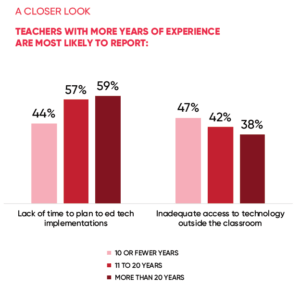The 4th Annual Educator Confidence Report released by Houghton Mifflin Harcourt late in 2018 has some interesting findings in it. More than 1,200 teachers and administrators across the country participated in the study that looked at “how educators perceive the state of education” and how they are using technology in the classroom for learning. While 1,200 is not a huge sample size, it does offer some possible themes that we can examine, themes that may point the way to improvements we as leaders can make.
Theme #1: Barriers to Technology Use Are Decreasing
While barriers to the effective use of technology for learning do exist, educators were more positive this year about their ability to overcome them. Barriers that still remain, however, include:
- Lack of time to plan for integration of digital resources into instruction – 52% of educators responding
- Inadequate student access to devices/internet outside the classroom – 42%
- Lack of devices for students in the classroom – 42%
- Device/network unreliability – 35%
- Lack of technology-focused professional development – 33%
- Lack of digital curriculum-focused professional development – 30%

It is interesting to note that teachers with more years of experience in the field are more likely to report that lack of time to plan ed tech implementations is a big barrier while those with less experience find inadequate access to tech at home as the biggest barrier.
District leaders should consider how they can provide more time for teacher planning for the use of digital resources, along with more professional development offerings focused on technology and digital curriculum. A blended learning approach might work well for both of these needs.
Another finding from the study has to do with how teachers prefer to learn about the use of instructional technology. 62% of the respondents felt that informal discussions with colleagues was the most impactful way for them to learn how to support the use of technology in the classroom. This was considerably higher than formal professional development provided by the district/campus (49%) or self-guided research (41%). This clearly shows that teachers prefer the opportunity to learn from their peers what works and what doesn’t.
Theme #2: Teacher Confidence in Using Technology Remains About the Same
In the survey, 58% of the teachers responded that they are extremely or very confident in their ability to use ed tech in instructionally effective ways. This compares to 54% in 2016 and 62% in 2017. Again, however, differences appear when you examine the number of years of experience that respondents have. While 64% of those with 10 or fewer years of teaching are confident, only 49% of those with more than 20 years experience feel the same.
This is a gap that must be addressed by leadership, perhaps through more individualized learning opportunities or by pairing younger and more experienced teachers together for learning. Since the study showed that teachers prefer to learn from their peers, paired professional development with ample time for discussion and experimentation is critical.
Theme #3: Teacher Use of Digital Tools Is Up
More and more educators are using digital materials to help their students master content. The most used tools include:
- Videos from an instructional program or open source (66%)
- Digital communication tools to engage with parents (65%)
- Resources shared via a (free or paid) professional, online community (such as TCEA’s Community) (64%)
- Digital versions of print instructional materials (59%)
- Practice work apps/websites/digital games (58%)
Learning Management Systems saw a significant increase in use, rising to 51% of respondents.
However, while more teachers are using digital resources in the classroom, most of their use remains at the lower levels of Bloom’s Taxonomy: watching a video, looking at print-into-digital resources, and using practice apps. Fewer of the uses at the creativity or collaboration level are being seen even today.
In addition, more teachers are using social media as a way to explore teaching and instructional content. 80% of survey respondents say they use it for that purpose, while 74% use it to communicate/interact with students’ families and 72% use it to interact with other educators.
Conclusions
As leaders, the biggest take-aways from this latest study are that teachers are amazing professionals who want to grow and improve. They definitely see the value that technology can offer for student learning, but need more structured time with peers to practice and master it. How will you make this happen for your teachers?

